The Impact of Colonisation on Indigenous Australians: A Deep Dive
VerifiedAdded on 2023/01/11
|12
|3974
|28
Essay
AI Summary
This essay delves into the enduring consequences of colonisation on Indigenous Australians, exploring the roots of mistrust and its impact on interactions with family violence support agencies. It analyzes aspects of contemporary disadvantage stemming from colonisation, relevant to social realities. The essay further investigates the historical role of the police in the colonisation process and how this history continues to shape contemporary relations with Indigenous people, offering insights for future police officers. Finally, it examines the over-representation of Indigenous people in the criminal justice system since the Royal Commission into Aboriginal Deaths in Custody, identifying interconnecting factors and offering guidance for future professional practice. The essay utilizes research to support its arguments and provides references for further reading.
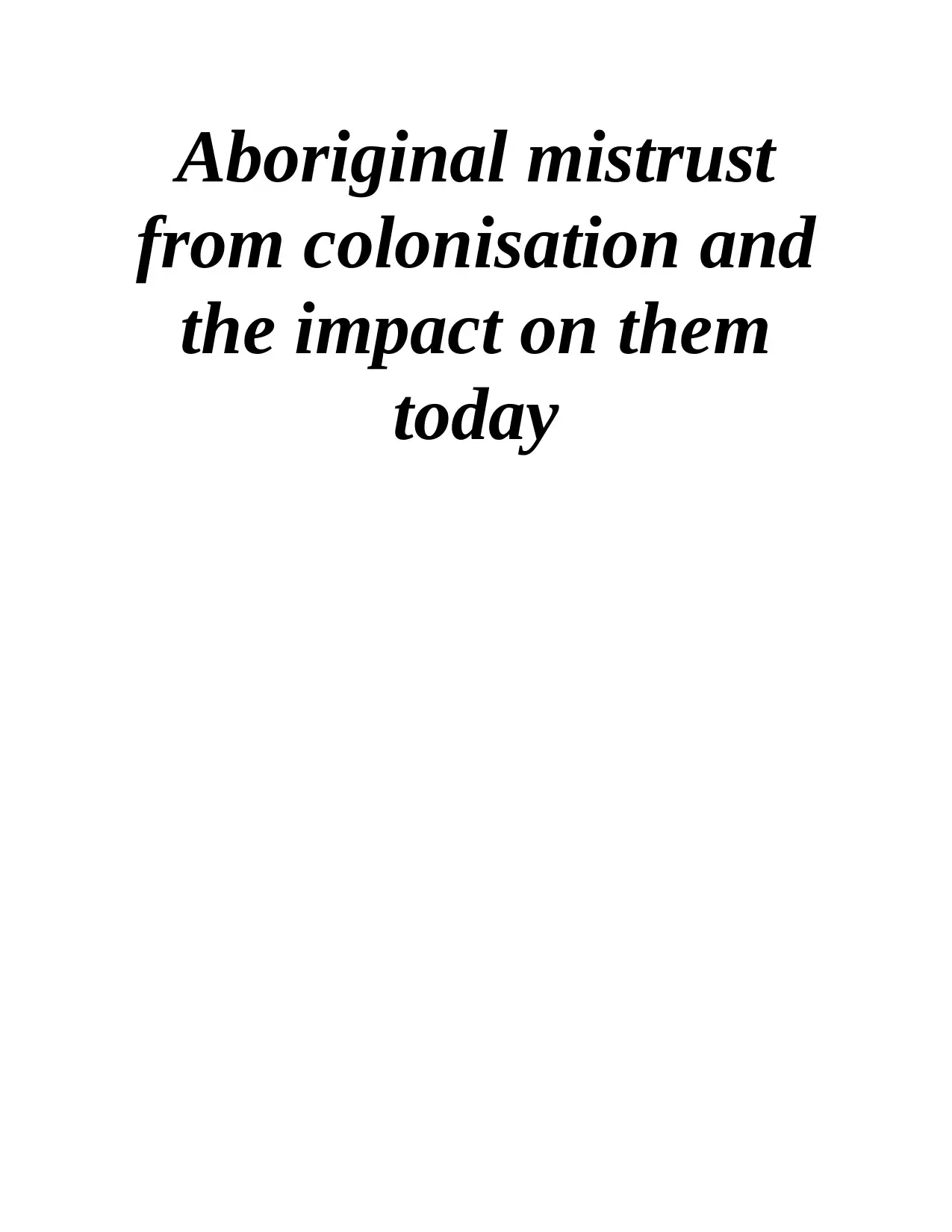
Aboriginal mistrust
from colonisation and
the impact on them
today
from colonisation and
the impact on them
today
Paraphrase This Document
Need a fresh take? Get an instant paraphrase of this document with our AI Paraphraser
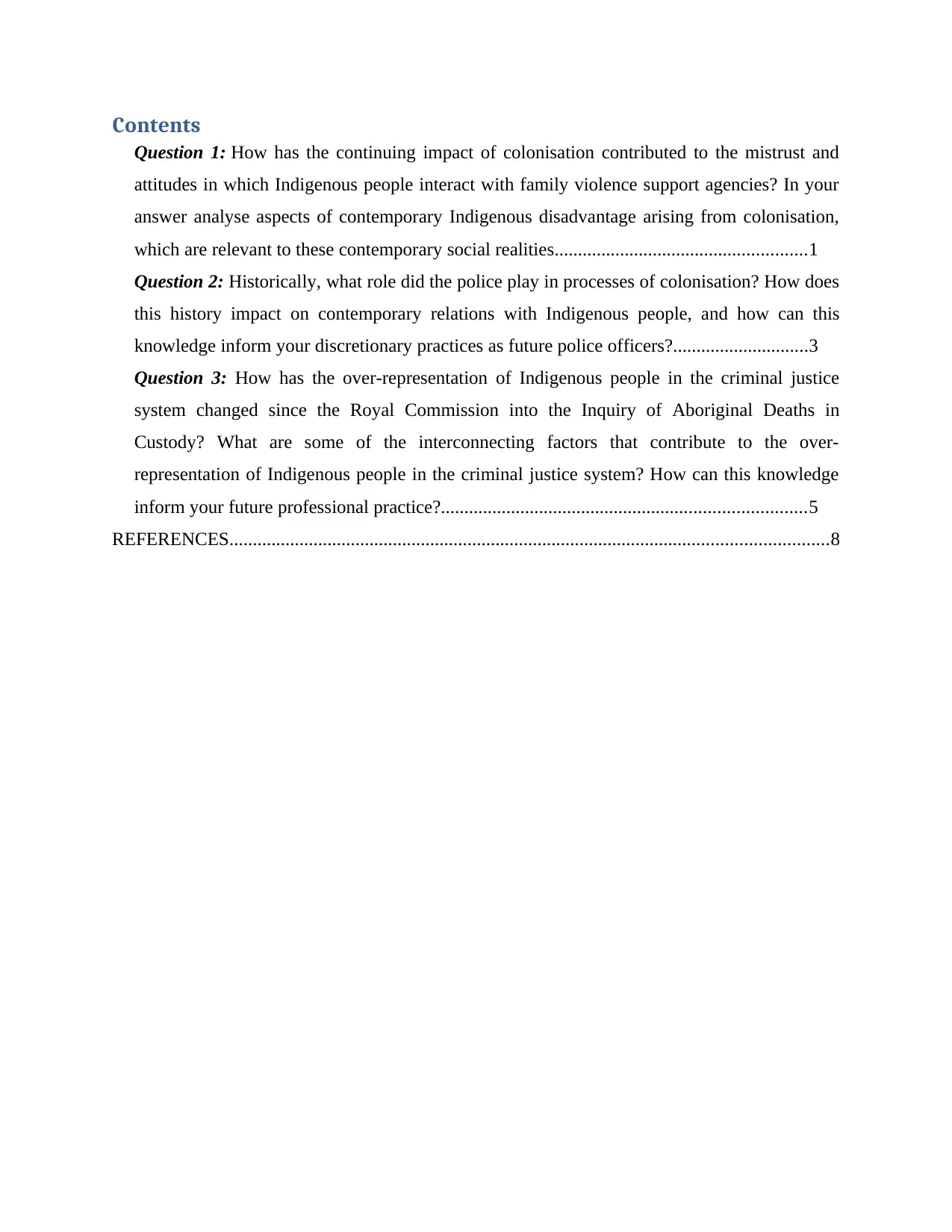
Contents
Question 1: How has the continuing impact of colonisation contributed to the mistrust and
attitudes in which Indigenous people interact with family violence support agencies? In your
answer analyse aspects of contemporary Indigenous disadvantage arising from colonisation,
which are relevant to these contemporary social realities......................................................1
Question 2: Historically, what role did the police play in processes of colonisation? How does
this history impact on contemporary relations with Indigenous people, and how can this
knowledge inform your discretionary practices as future police officers?.............................3
Question 3: How has the over-representation of Indigenous people in the criminal justice
system changed since the Royal Commission into the Inquiry of Aboriginal Deaths in
Custody? What are some of the interconnecting factors that contribute to the over-
representation of Indigenous people in the criminal justice system? How can this knowledge
inform your future professional practice?..............................................................................5
REFERENCES................................................................................................................................8
Question 1: How has the continuing impact of colonisation contributed to the mistrust and
attitudes in which Indigenous people interact with family violence support agencies? In your
answer analyse aspects of contemporary Indigenous disadvantage arising from colonisation,
which are relevant to these contemporary social realities......................................................1
Question 2: Historically, what role did the police play in processes of colonisation? How does
this history impact on contemporary relations with Indigenous people, and how can this
knowledge inform your discretionary practices as future police officers?.............................3
Question 3: How has the over-representation of Indigenous people in the criminal justice
system changed since the Royal Commission into the Inquiry of Aboriginal Deaths in
Custody? What are some of the interconnecting factors that contribute to the over-
representation of Indigenous people in the criminal justice system? How can this knowledge
inform your future professional practice?..............................................................................5
REFERENCES................................................................................................................................8

⊘ This is a preview!⊘
Do you want full access?
Subscribe today to unlock all pages.

Trusted by 1+ million students worldwide
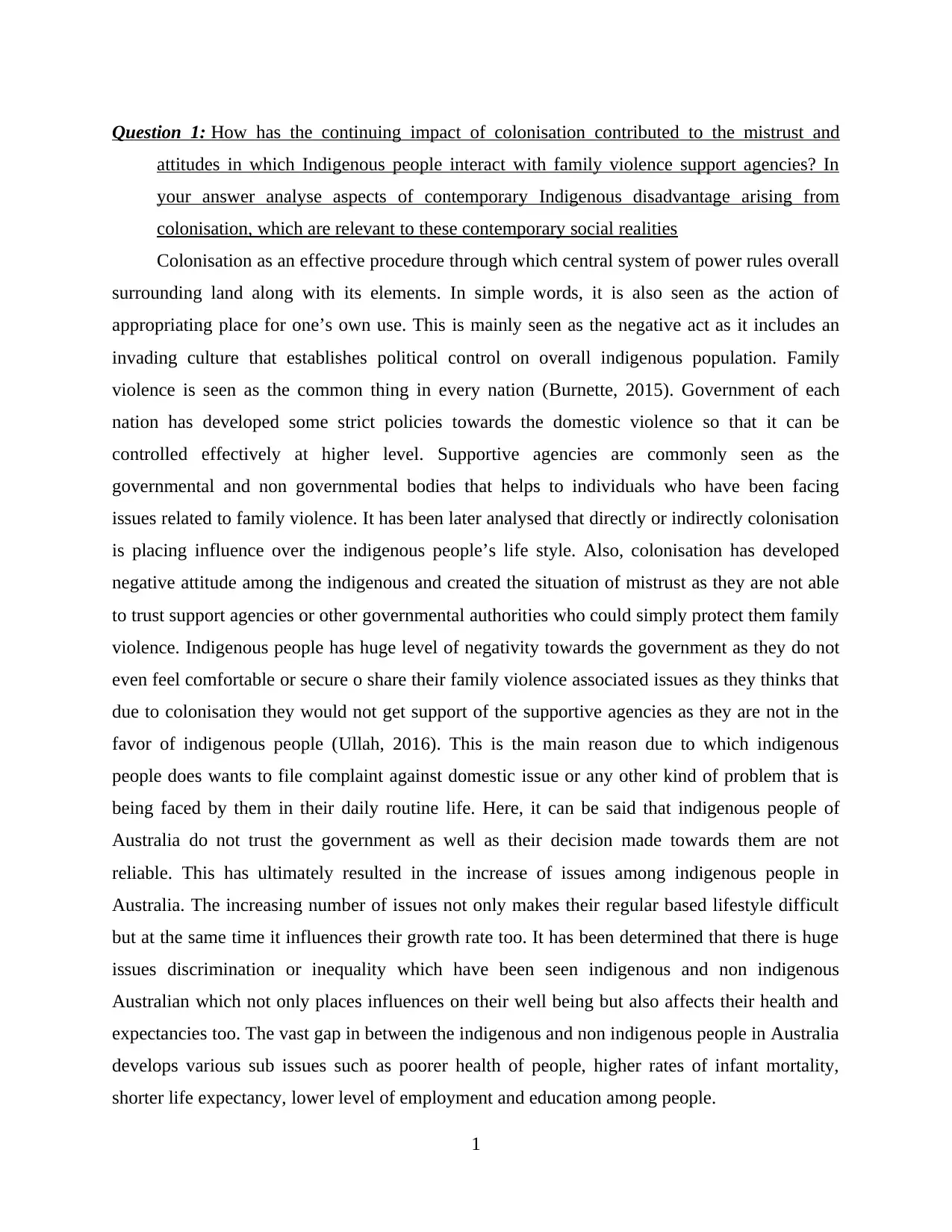
Question 1: How has the continuing impact of colonisation contributed to the mistrust and
attitudes in which Indigenous people interact with family violence support agencies? In
your answer analyse aspects of contemporary Indigenous disadvantage arising from
colonisation, which are relevant to these contemporary social realities
Colonisation as an effective procedure through which central system of power rules overall
surrounding land along with its elements. In simple words, it is also seen as the action of
appropriating place for one’s own use. This is mainly seen as the negative act as it includes an
invading culture that establishes political control on overall indigenous population. Family
violence is seen as the common thing in every nation (Burnette, 2015). Government of each
nation has developed some strict policies towards the domestic violence so that it can be
controlled effectively at higher level. Supportive agencies are commonly seen as the
governmental and non governmental bodies that helps to individuals who have been facing
issues related to family violence. It has been later analysed that directly or indirectly colonisation
is placing influence over the indigenous people’s life style. Also, colonisation has developed
negative attitude among the indigenous and created the situation of mistrust as they are not able
to trust support agencies or other governmental authorities who could simply protect them family
violence. Indigenous people has huge level of negativity towards the government as they do not
even feel comfortable or secure o share their family violence associated issues as they thinks that
due to colonisation they would not get support of the supportive agencies as they are not in the
favor of indigenous people (Ullah, 2016). This is the main reason due to which indigenous
people does wants to file complaint against domestic issue or any other kind of problem that is
being faced by them in their daily routine life. Here, it can be said that indigenous people of
Australia do not trust the government as well as their decision made towards them are not
reliable. This has ultimately resulted in the increase of issues among indigenous people in
Australia. The increasing number of issues not only makes their regular based lifestyle difficult
but at the same time it influences their growth rate too. It has been determined that there is huge
issues discrimination or inequality which have been seen indigenous and non indigenous
Australian which not only places influences on their well being but also affects their health and
expectancies too. The vast gap in between the indigenous and non indigenous people in Australia
develops various sub issues such as poorer health of people, higher rates of infant mortality,
shorter life expectancy, lower level of employment and education among people.
1
attitudes in which Indigenous people interact with family violence support agencies? In
your answer analyse aspects of contemporary Indigenous disadvantage arising from
colonisation, which are relevant to these contemporary social realities
Colonisation as an effective procedure through which central system of power rules overall
surrounding land along with its elements. In simple words, it is also seen as the action of
appropriating place for one’s own use. This is mainly seen as the negative act as it includes an
invading culture that establishes political control on overall indigenous population. Family
violence is seen as the common thing in every nation (Burnette, 2015). Government of each
nation has developed some strict policies towards the domestic violence so that it can be
controlled effectively at higher level. Supportive agencies are commonly seen as the
governmental and non governmental bodies that helps to individuals who have been facing
issues related to family violence. It has been later analysed that directly or indirectly colonisation
is placing influence over the indigenous people’s life style. Also, colonisation has developed
negative attitude among the indigenous and created the situation of mistrust as they are not able
to trust support agencies or other governmental authorities who could simply protect them family
violence. Indigenous people has huge level of negativity towards the government as they do not
even feel comfortable or secure o share their family violence associated issues as they thinks that
due to colonisation they would not get support of the supportive agencies as they are not in the
favor of indigenous people (Ullah, 2016). This is the main reason due to which indigenous
people does wants to file complaint against domestic issue or any other kind of problem that is
being faced by them in their daily routine life. Here, it can be said that indigenous people of
Australia do not trust the government as well as their decision made towards them are not
reliable. This has ultimately resulted in the increase of issues among indigenous people in
Australia. The increasing number of issues not only makes their regular based lifestyle difficult
but at the same time it influences their growth rate too. It has been determined that there is huge
issues discrimination or inequality which have been seen indigenous and non indigenous
Australian which not only places influences on their well being but also affects their health and
expectancies too. The vast gap in between the indigenous and non indigenous people in Australia
develops various sub issues such as poorer health of people, higher rates of infant mortality,
shorter life expectancy, lower level of employment and education among people.
1
Paraphrase This Document
Need a fresh take? Get an instant paraphrase of this document with our AI Paraphraser
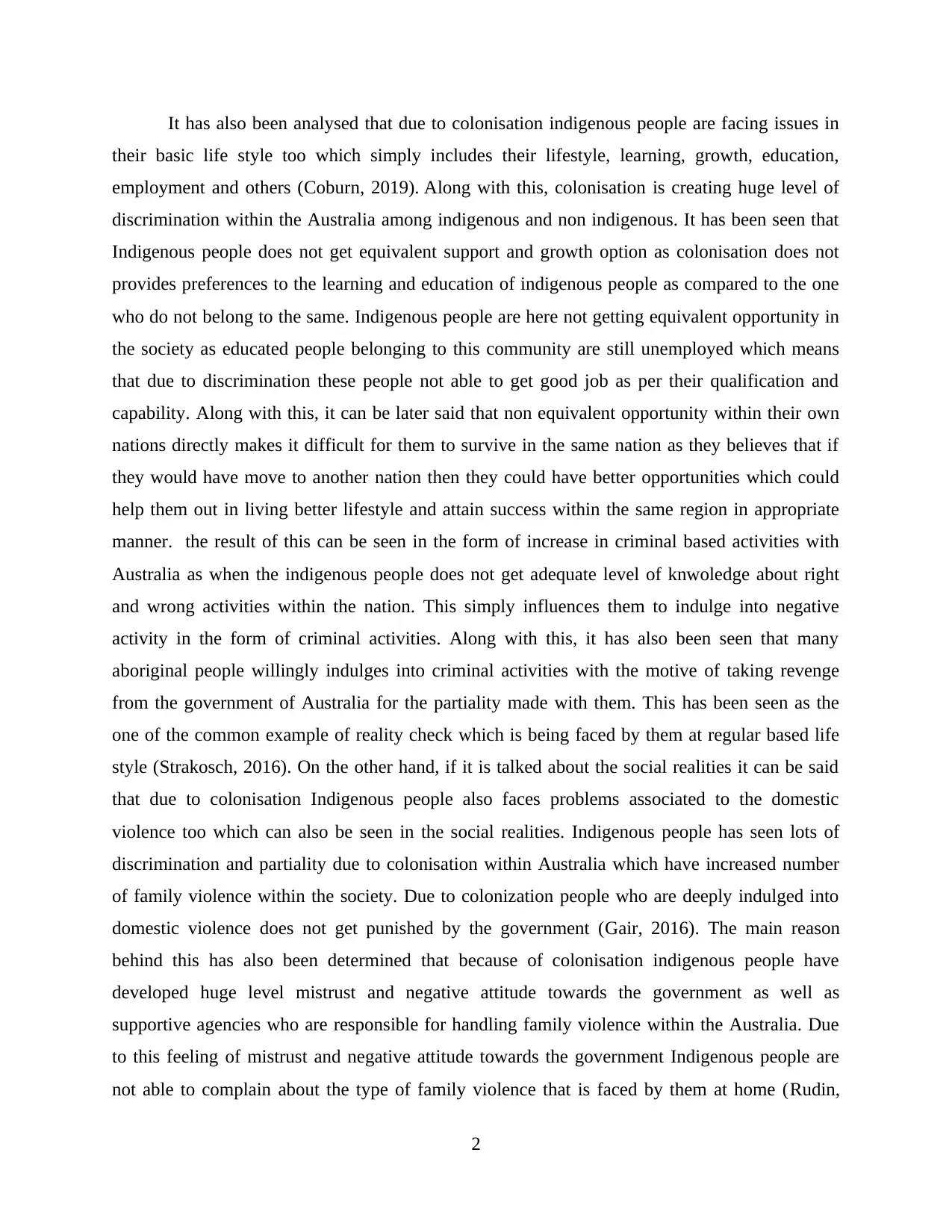
It has also been analysed that due to colonisation indigenous people are facing issues in
their basic life style too which simply includes their lifestyle, learning, growth, education,
employment and others (Coburn, 2019). Along with this, colonisation is creating huge level of
discrimination within the Australia among indigenous and non indigenous. It has been seen that
Indigenous people does not get equivalent support and growth option as colonisation does not
provides preferences to the learning and education of indigenous people as compared to the one
who do not belong to the same. Indigenous people are here not getting equivalent opportunity in
the society as educated people belonging to this community are still unemployed which means
that due to discrimination these people not able to get good job as per their qualification and
capability. Along with this, it can be later said that non equivalent opportunity within their own
nations directly makes it difficult for them to survive in the same nation as they believes that if
they would have move to another nation then they could have better opportunities which could
help them out in living better lifestyle and attain success within the same region in appropriate
manner. the result of this can be seen in the form of increase in criminal based activities with
Australia as when the indigenous people does not get adequate level of knwoledge about right
and wrong activities within the nation. This simply influences them to indulge into negative
activity in the form of criminal activities. Along with this, it has also been seen that many
aboriginal people willingly indulges into criminal activities with the motive of taking revenge
from the government of Australia for the partiality made with them. This has been seen as the
one of the common example of reality check which is being faced by them at regular based life
style (Strakosch, 2016). On the other hand, if it is talked about the social realities it can be said
that due to colonisation Indigenous people also faces problems associated to the domestic
violence too which can also be seen in the social realities. Indigenous people has seen lots of
discrimination and partiality due to colonisation within Australia which have increased number
of family violence within the society. Due to colonization people who are deeply indulged into
domestic violence does not get punished by the government (Gair, 2016). The main reason
behind this has also been determined that because of colonisation indigenous people have
developed huge level mistrust and negative attitude towards the government as well as
supportive agencies who are responsible for handling family violence within the Australia. Due
to this feeling of mistrust and negative attitude towards the government Indigenous people are
not able to complain about the type of family violence that is faced by them at home (Rudin,
2
their basic life style too which simply includes their lifestyle, learning, growth, education,
employment and others (Coburn, 2019). Along with this, colonisation is creating huge level of
discrimination within the Australia among indigenous and non indigenous. It has been seen that
Indigenous people does not get equivalent support and growth option as colonisation does not
provides preferences to the learning and education of indigenous people as compared to the one
who do not belong to the same. Indigenous people are here not getting equivalent opportunity in
the society as educated people belonging to this community are still unemployed which means
that due to discrimination these people not able to get good job as per their qualification and
capability. Along with this, it can be later said that non equivalent opportunity within their own
nations directly makes it difficult for them to survive in the same nation as they believes that if
they would have move to another nation then they could have better opportunities which could
help them out in living better lifestyle and attain success within the same region in appropriate
manner. the result of this can be seen in the form of increase in criminal based activities with
Australia as when the indigenous people does not get adequate level of knwoledge about right
and wrong activities within the nation. This simply influences them to indulge into negative
activity in the form of criminal activities. Along with this, it has also been seen that many
aboriginal people willingly indulges into criminal activities with the motive of taking revenge
from the government of Australia for the partiality made with them. This has been seen as the
one of the common example of reality check which is being faced by them at regular based life
style (Strakosch, 2016). On the other hand, if it is talked about the social realities it can be said
that due to colonisation Indigenous people also faces problems associated to the domestic
violence too which can also be seen in the social realities. Indigenous people has seen lots of
discrimination and partiality due to colonisation within Australia which have increased number
of family violence within the society. Due to colonization people who are deeply indulged into
domestic violence does not get punished by the government (Gair, 2016). The main reason
behind this has also been determined that because of colonisation indigenous people have
developed huge level mistrust and negative attitude towards the government as well as
supportive agencies who are responsible for handling family violence within the Australia. Due
to this feeling of mistrust and negative attitude towards the government Indigenous people are
not able to complain about the type of family violence that is faced by them at home (Rudin,
2
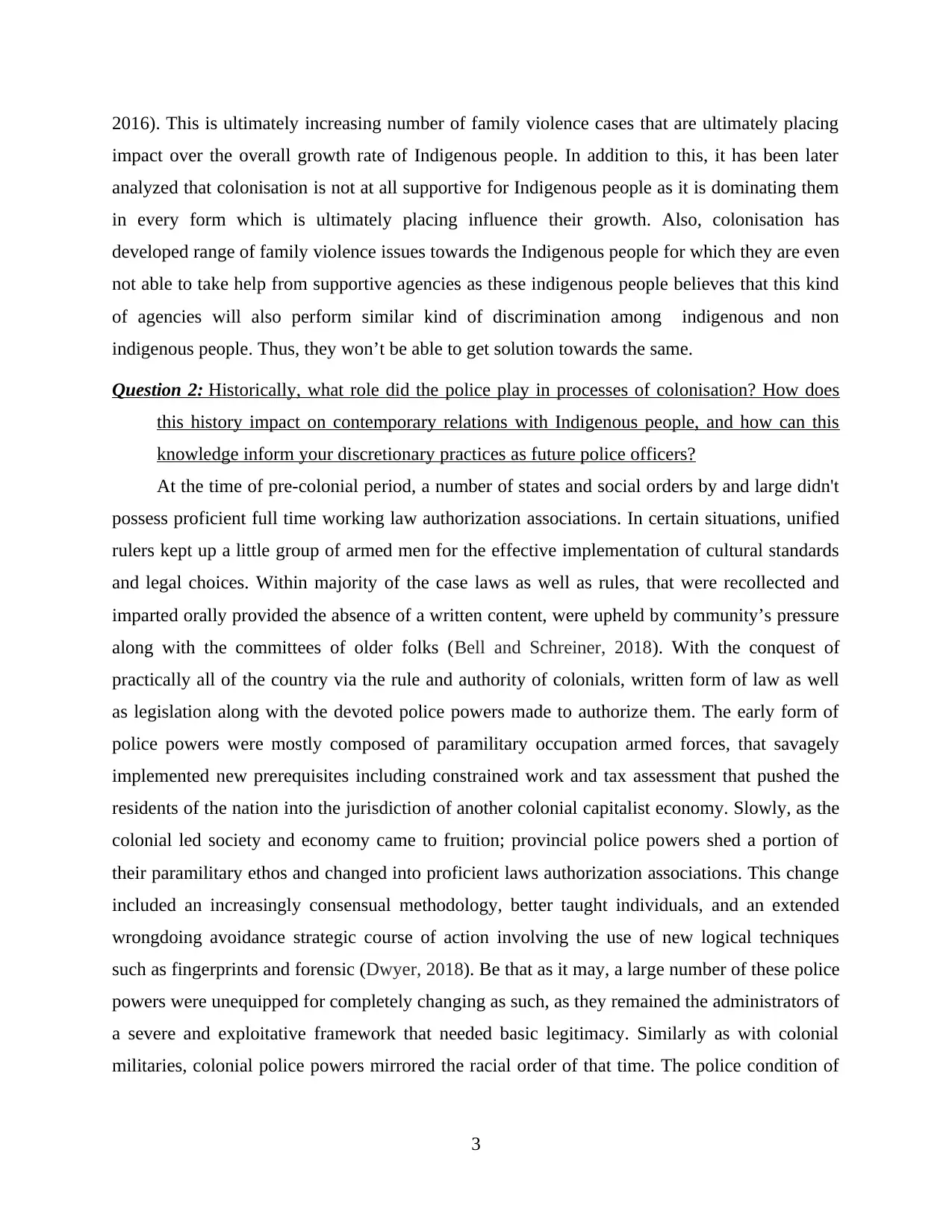
2016). This is ultimately increasing number of family violence cases that are ultimately placing
impact over the overall growth rate of Indigenous people. In addition to this, it has been later
analyzed that colonisation is not at all supportive for Indigenous people as it is dominating them
in every form which is ultimately placing influence their growth. Also, colonisation has
developed range of family violence issues towards the Indigenous people for which they are even
not able to take help from supportive agencies as these indigenous people believes that this kind
of agencies will also perform similar kind of discrimination among indigenous and non
indigenous people. Thus, they won’t be able to get solution towards the same.
Question 2: Historically, what role did the police play in processes of colonisation? How does
this history impact on contemporary relations with Indigenous people, and how can this
knowledge inform your discretionary practices as future police officers?
At the time of pre-colonial period, a number of states and social orders by and large didn't
possess proficient full time working law authorization associations. In certain situations, unified
rulers kept up a little group of armed men for the effective implementation of cultural standards
and legal choices. Within majority of the case laws as well as rules, that were recollected and
imparted orally provided the absence of a written content, were upheld by community’s pressure
along with the committees of older folks (Bell and Schreiner, 2018). With the conquest of
practically all of the country via the rule and authority of colonials, written form of law as well
as legislation along with the devoted police powers made to authorize them. The early form of
police powers were mostly composed of paramilitary occupation armed forces, that savagely
implemented new prerequisites including constrained work and tax assessment that pushed the
residents of the nation into the jurisdiction of another colonial capitalist economy. Slowly, as the
colonial led society and economy came to fruition; provincial police powers shed a portion of
their paramilitary ethos and changed into proficient laws authorization associations. This change
included an increasingly consensual methodology, better taught individuals, and an extended
wrongdoing avoidance strategic course of action involving the use of new logical techniques
such as fingerprints and forensic (Dwyer, 2018). Be that as it may, a large number of these police
powers were unequipped for completely changing as such, as they remained the administrators of
a severe and exploitative framework that needed basic legitimacy. Similarly as with colonial
militaries, colonial police powers mirrored the racial order of that time. The police condition of
3
impact over the overall growth rate of Indigenous people. In addition to this, it has been later
analyzed that colonisation is not at all supportive for Indigenous people as it is dominating them
in every form which is ultimately placing influence their growth. Also, colonisation has
developed range of family violence issues towards the Indigenous people for which they are even
not able to take help from supportive agencies as these indigenous people believes that this kind
of agencies will also perform similar kind of discrimination among indigenous and non
indigenous people. Thus, they won’t be able to get solution towards the same.
Question 2: Historically, what role did the police play in processes of colonisation? How does
this history impact on contemporary relations with Indigenous people, and how can this
knowledge inform your discretionary practices as future police officers?
At the time of pre-colonial period, a number of states and social orders by and large didn't
possess proficient full time working law authorization associations. In certain situations, unified
rulers kept up a little group of armed men for the effective implementation of cultural standards
and legal choices. Within majority of the case laws as well as rules, that were recollected and
imparted orally provided the absence of a written content, were upheld by community’s pressure
along with the committees of older folks (Bell and Schreiner, 2018). With the conquest of
practically all of the country via the rule and authority of colonials, written form of law as well
as legislation along with the devoted police powers made to authorize them. The early form of
police powers were mostly composed of paramilitary occupation armed forces, that savagely
implemented new prerequisites including constrained work and tax assessment that pushed the
residents of the nation into the jurisdiction of another colonial capitalist economy. Slowly, as the
colonial led society and economy came to fruition; provincial police powers shed a portion of
their paramilitary ethos and changed into proficient laws authorization associations. This change
included an increasingly consensual methodology, better taught individuals, and an extended
wrongdoing avoidance strategic course of action involving the use of new logical techniques
such as fingerprints and forensic (Dwyer, 2018). Be that as it may, a large number of these police
powers were unequipped for completely changing as such, as they remained the administrators of
a severe and exploitative framework that needed basic legitimacy. Similarly as with colonial
militaries, colonial police powers mirrored the racial order of that time. The police condition of
3
⊘ This is a preview!⊘
Do you want full access?
Subscribe today to unlock all pages.

Trusted by 1+ million students worldwide
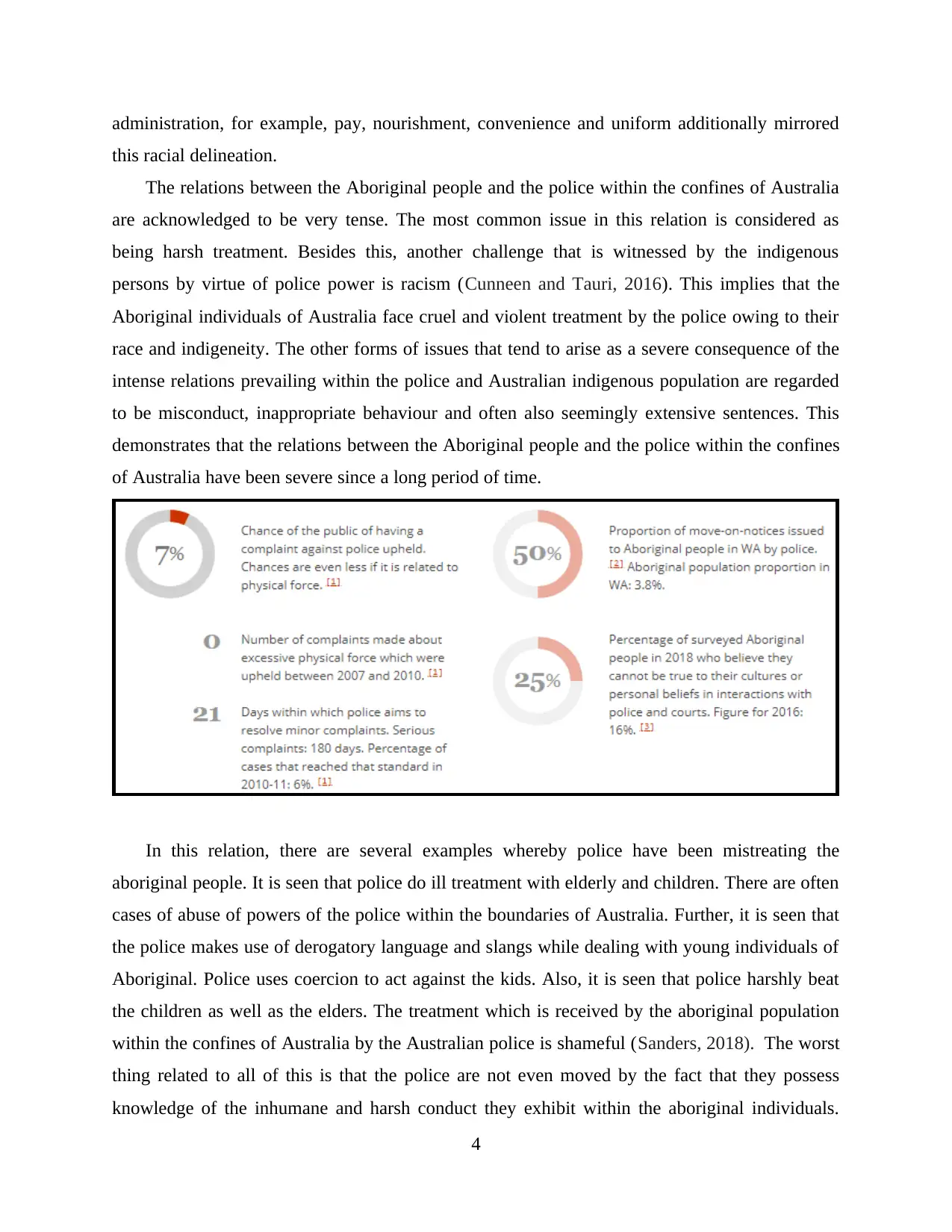
administration, for example, pay, nourishment, convenience and uniform additionally mirrored
this racial delineation.
The relations between the Aboriginal people and the police within the confines of Australia
are acknowledged to be very tense. The most common issue in this relation is considered as
being harsh treatment. Besides this, another challenge that is witnessed by the indigenous
persons by virtue of police power is racism (Cunneen and Tauri, 2016). This implies that the
Aboriginal individuals of Australia face cruel and violent treatment by the police owing to their
race and indigeneity. The other forms of issues that tend to arise as a severe consequence of the
intense relations prevailing within the police and Australian indigenous population are regarded
to be misconduct, inappropriate behaviour and often also seemingly extensive sentences. This
demonstrates that the relations between the Aboriginal people and the police within the confines
of Australia have been severe since a long period of time.
In this relation, there are several examples whereby police have been mistreating the
aboriginal people. It is seen that police do ill treatment with elderly and children. There are often
cases of abuse of powers of the police within the boundaries of Australia. Further, it is seen that
the police makes use of derogatory language and slangs while dealing with young individuals of
Aboriginal. Police uses coercion to act against the kids. Also, it is seen that police harshly beat
the children as well as the elders. The treatment which is received by the aboriginal population
within the confines of Australia by the Australian police is shameful (Sanders, 2018). The worst
thing related to all of this is that the police are not even moved by the fact that they possess
knowledge of the inhumane and harsh conduct they exhibit within the aboriginal individuals.
4
this racial delineation.
The relations between the Aboriginal people and the police within the confines of Australia
are acknowledged to be very tense. The most common issue in this relation is considered as
being harsh treatment. Besides this, another challenge that is witnessed by the indigenous
persons by virtue of police power is racism (Cunneen and Tauri, 2016). This implies that the
Aboriginal individuals of Australia face cruel and violent treatment by the police owing to their
race and indigeneity. The other forms of issues that tend to arise as a severe consequence of the
intense relations prevailing within the police and Australian indigenous population are regarded
to be misconduct, inappropriate behaviour and often also seemingly extensive sentences. This
demonstrates that the relations between the Aboriginal people and the police within the confines
of Australia have been severe since a long period of time.
In this relation, there are several examples whereby police have been mistreating the
aboriginal people. It is seen that police do ill treatment with elderly and children. There are often
cases of abuse of powers of the police within the boundaries of Australia. Further, it is seen that
the police makes use of derogatory language and slangs while dealing with young individuals of
Aboriginal. Police uses coercion to act against the kids. Also, it is seen that police harshly beat
the children as well as the elders. The treatment which is received by the aboriginal population
within the confines of Australia by the Australian police is shameful (Sanders, 2018). The worst
thing related to all of this is that the police are not even moved by the fact that they possess
knowledge of the inhumane and harsh conduct they exhibit within the aboriginal individuals.
4
Paraphrase This Document
Need a fresh take? Get an instant paraphrase of this document with our AI Paraphraser
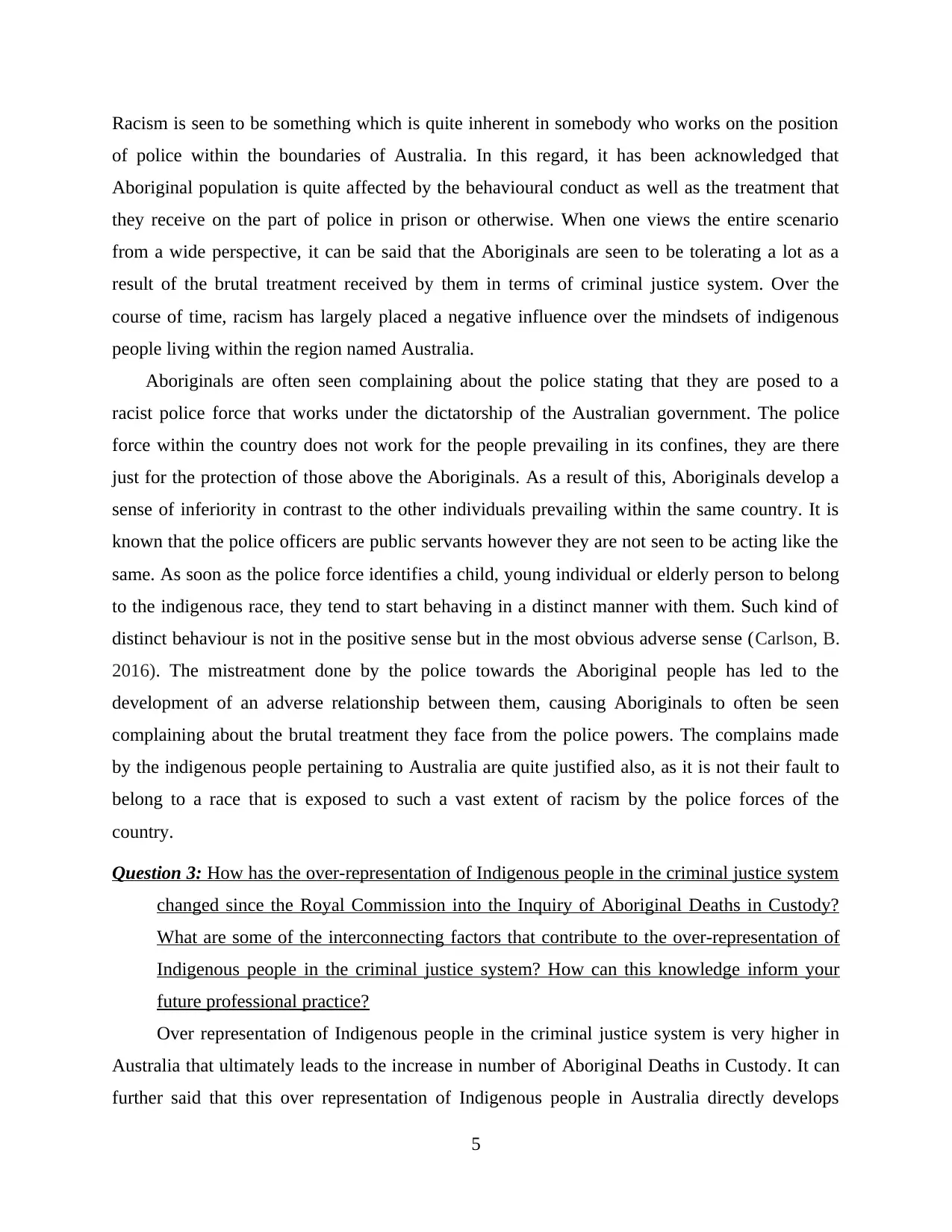
Racism is seen to be something which is quite inherent in somebody who works on the position
of police within the boundaries of Australia. In this regard, it has been acknowledged that
Aboriginal population is quite affected by the behavioural conduct as well as the treatment that
they receive on the part of police in prison or otherwise. When one views the entire scenario
from a wide perspective, it can be said that the Aboriginals are seen to be tolerating a lot as a
result of the brutal treatment received by them in terms of criminal justice system. Over the
course of time, racism has largely placed a negative influence over the mindsets of indigenous
people living within the region named Australia.
Aboriginals are often seen complaining about the police stating that they are posed to a
racist police force that works under the dictatorship of the Australian government. The police
force within the country does not work for the people prevailing in its confines, they are there
just for the protection of those above the Aboriginals. As a result of this, Aboriginals develop a
sense of inferiority in contrast to the other individuals prevailing within the same country. It is
known that the police officers are public servants however they are not seen to be acting like the
same. As soon as the police force identifies a child, young individual or elderly person to belong
to the indigenous race, they tend to start behaving in a distinct manner with them. Such kind of
distinct behaviour is not in the positive sense but in the most obvious adverse sense (Carlson, B.
2016). The mistreatment done by the police towards the Aboriginal people has led to the
development of an adverse relationship between them, causing Aboriginals to often be seen
complaining about the brutal treatment they face from the police powers. The complains made
by the indigenous people pertaining to Australia are quite justified also, as it is not their fault to
belong to a race that is exposed to such a vast extent of racism by the police forces of the
country.
Question 3: How has the over-representation of Indigenous people in the criminal justice system
changed since the Royal Commission into the Inquiry of Aboriginal Deaths in Custody?
What are some of the interconnecting factors that contribute to the over-representation of
Indigenous people in the criminal justice system? How can this knowledge inform your
future professional practice?
Over representation of Indigenous people in the criminal justice system is very higher in
Australia that ultimately leads to the increase in number of Aboriginal Deaths in Custody. It can
further said that this over representation of Indigenous people in Australia directly develops
5
of police within the boundaries of Australia. In this regard, it has been acknowledged that
Aboriginal population is quite affected by the behavioural conduct as well as the treatment that
they receive on the part of police in prison or otherwise. When one views the entire scenario
from a wide perspective, it can be said that the Aboriginals are seen to be tolerating a lot as a
result of the brutal treatment received by them in terms of criminal justice system. Over the
course of time, racism has largely placed a negative influence over the mindsets of indigenous
people living within the region named Australia.
Aboriginals are often seen complaining about the police stating that they are posed to a
racist police force that works under the dictatorship of the Australian government. The police
force within the country does not work for the people prevailing in its confines, they are there
just for the protection of those above the Aboriginals. As a result of this, Aboriginals develop a
sense of inferiority in contrast to the other individuals prevailing within the same country. It is
known that the police officers are public servants however they are not seen to be acting like the
same. As soon as the police force identifies a child, young individual or elderly person to belong
to the indigenous race, they tend to start behaving in a distinct manner with them. Such kind of
distinct behaviour is not in the positive sense but in the most obvious adverse sense (Carlson, B.
2016). The mistreatment done by the police towards the Aboriginal people has led to the
development of an adverse relationship between them, causing Aboriginals to often be seen
complaining about the brutal treatment they face from the police powers. The complains made
by the indigenous people pertaining to Australia are quite justified also, as it is not their fault to
belong to a race that is exposed to such a vast extent of racism by the police forces of the
country.
Question 3: How has the over-representation of Indigenous people in the criminal justice system
changed since the Royal Commission into the Inquiry of Aboriginal Deaths in Custody?
What are some of the interconnecting factors that contribute to the over-representation of
Indigenous people in the criminal justice system? How can this knowledge inform your
future professional practice?
Over representation of Indigenous people in the criminal justice system is very higher in
Australia that ultimately leads to the increase in number of Aboriginal Deaths in Custody. It can
further said that this over representation of Indigenous people in Australia directly develops
5
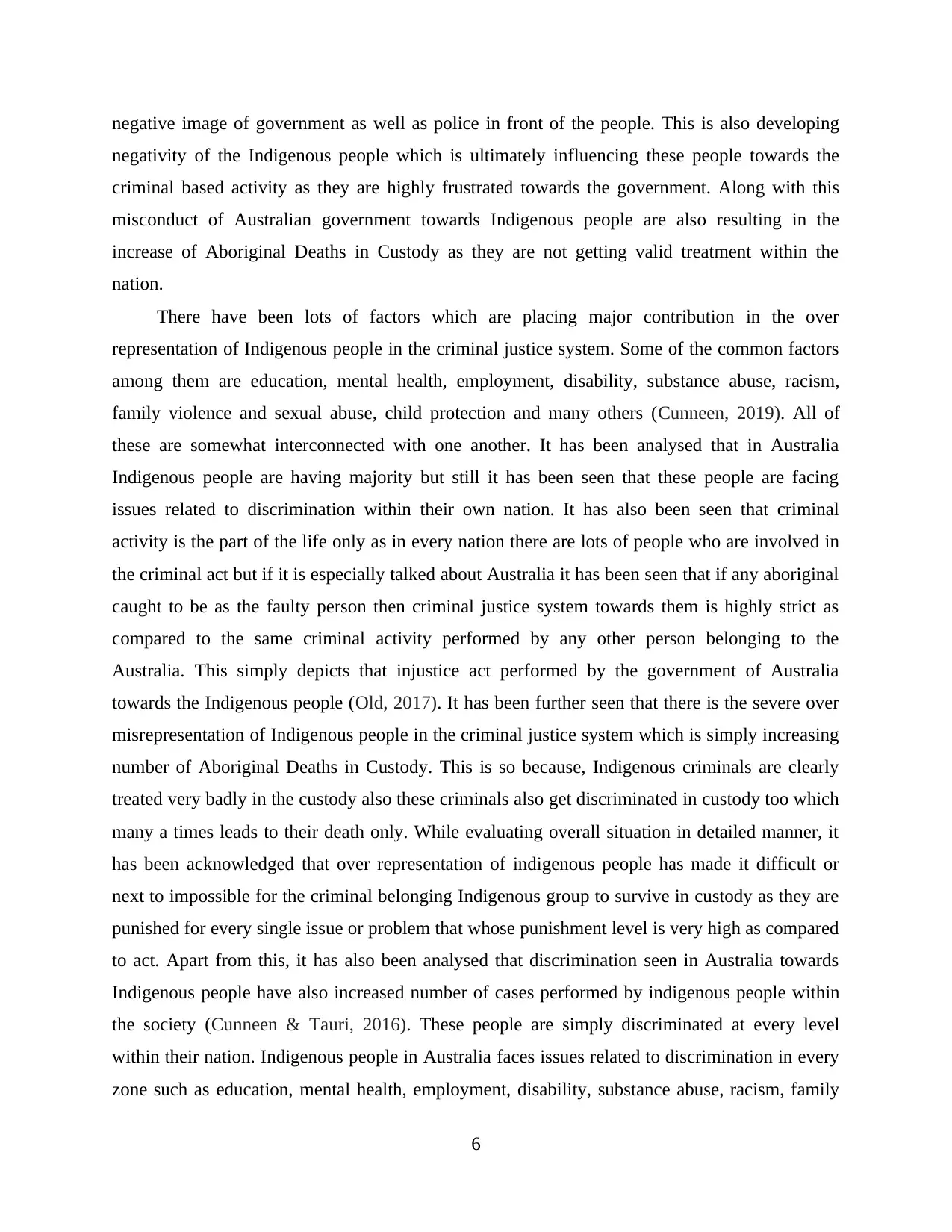
negative image of government as well as police in front of the people. This is also developing
negativity of the Indigenous people which is ultimately influencing these people towards the
criminal based activity as they are highly frustrated towards the government. Along with this
misconduct of Australian government towards Indigenous people are also resulting in the
increase of Aboriginal Deaths in Custody as they are not getting valid treatment within the
nation.
There have been lots of factors which are placing major contribution in the over
representation of Indigenous people in the criminal justice system. Some of the common factors
among them are education, mental health, employment, disability, substance abuse, racism,
family violence and sexual abuse, child protection and many others (Cunneen, 2019). All of
these are somewhat interconnected with one another. It has been analysed that in Australia
Indigenous people are having majority but still it has been seen that these people are facing
issues related to discrimination within their own nation. It has also been seen that criminal
activity is the part of the life only as in every nation there are lots of people who are involved in
the criminal act but if it is especially talked about Australia it has been seen that if any aboriginal
caught to be as the faulty person then criminal justice system towards them is highly strict as
compared to the same criminal activity performed by any other person belonging to the
Australia. This simply depicts that injustice act performed by the government of Australia
towards the Indigenous people (Old, 2017). It has been further seen that there is the severe over
misrepresentation of Indigenous people in the criminal justice system which is simply increasing
number of Aboriginal Deaths in Custody. This is so because, Indigenous criminals are clearly
treated very badly in the custody also these criminals also get discriminated in custody too which
many a times leads to their death only. While evaluating overall situation in detailed manner, it
has been acknowledged that over representation of indigenous people has made it difficult or
next to impossible for the criminal belonging Indigenous group to survive in custody as they are
punished for every single issue or problem that whose punishment level is very high as compared
to act. Apart from this, it has also been analysed that discrimination seen in Australia towards
Indigenous people have also increased number of cases performed by indigenous people within
the society (Cunneen & Tauri, 2016). These people are simply discriminated at every level
within their nation. Indigenous people in Australia faces issues related to discrimination in every
zone such as education, mental health, employment, disability, substance abuse, racism, family
6
negativity of the Indigenous people which is ultimately influencing these people towards the
criminal based activity as they are highly frustrated towards the government. Along with this
misconduct of Australian government towards Indigenous people are also resulting in the
increase of Aboriginal Deaths in Custody as they are not getting valid treatment within the
nation.
There have been lots of factors which are placing major contribution in the over
representation of Indigenous people in the criminal justice system. Some of the common factors
among them are education, mental health, employment, disability, substance abuse, racism,
family violence and sexual abuse, child protection and many others (Cunneen, 2019). All of
these are somewhat interconnected with one another. It has been analysed that in Australia
Indigenous people are having majority but still it has been seen that these people are facing
issues related to discrimination within their own nation. It has also been seen that criminal
activity is the part of the life only as in every nation there are lots of people who are involved in
the criminal act but if it is especially talked about Australia it has been seen that if any aboriginal
caught to be as the faulty person then criminal justice system towards them is highly strict as
compared to the same criminal activity performed by any other person belonging to the
Australia. This simply depicts that injustice act performed by the government of Australia
towards the Indigenous people (Old, 2017). It has been further seen that there is the severe over
misrepresentation of Indigenous people in the criminal justice system which is simply increasing
number of Aboriginal Deaths in Custody. This is so because, Indigenous criminals are clearly
treated very badly in the custody also these criminals also get discriminated in custody too which
many a times leads to their death only. While evaluating overall situation in detailed manner, it
has been acknowledged that over representation of indigenous people has made it difficult or
next to impossible for the criminal belonging Indigenous group to survive in custody as they are
punished for every single issue or problem that whose punishment level is very high as compared
to act. Apart from this, it has also been analysed that discrimination seen in Australia towards
Indigenous people have also increased number of cases performed by indigenous people within
the society (Cunneen & Tauri, 2016). These people are simply discriminated at every level
within their nation. Indigenous people in Australia faces issues related to discrimination in every
zone such as education, mental health, employment, disability, substance abuse, racism, family
6
⊘ This is a preview!⊘
Do you want full access?
Subscribe today to unlock all pages.

Trusted by 1+ million students worldwide
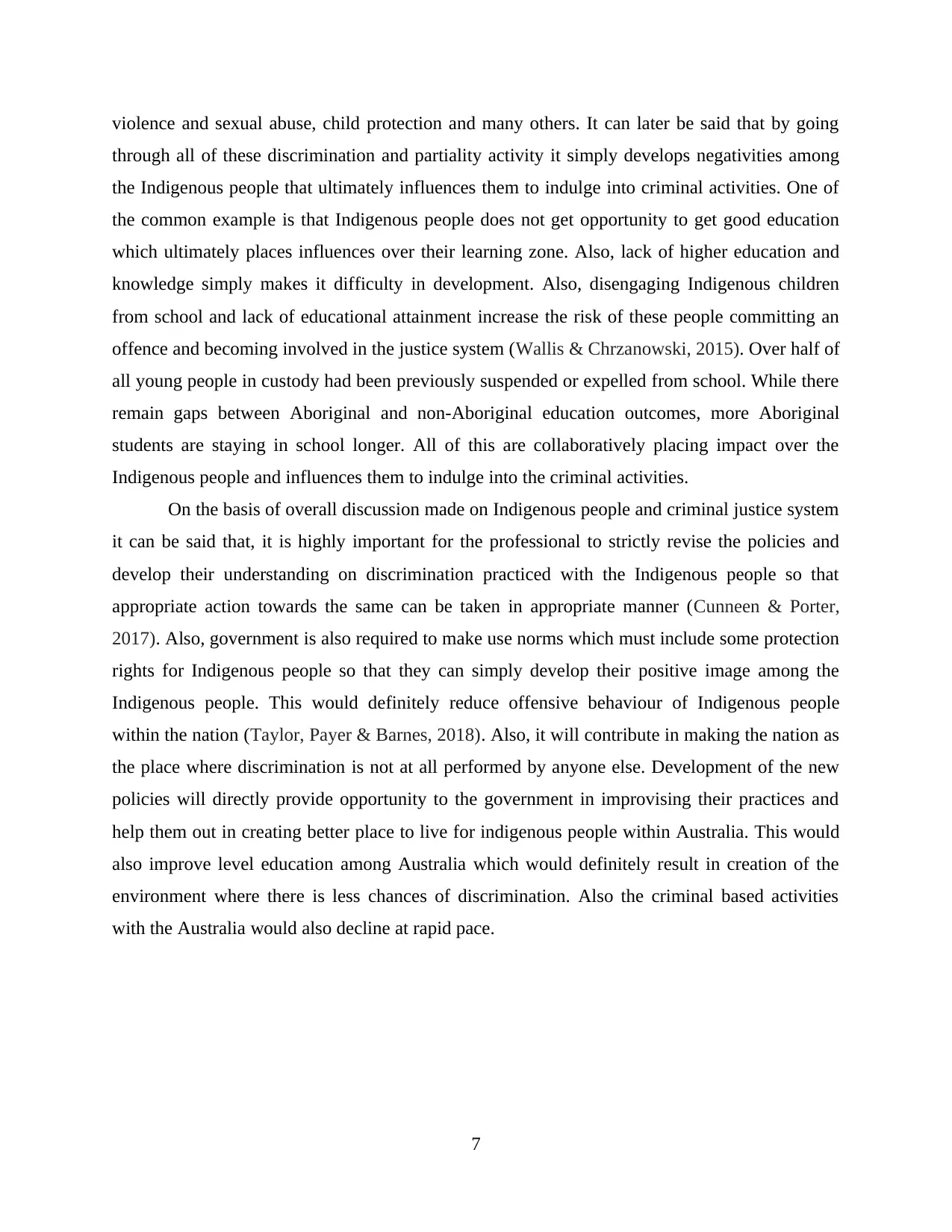
violence and sexual abuse, child protection and many others. It can later be said that by going
through all of these discrimination and partiality activity it simply develops negativities among
the Indigenous people that ultimately influences them to indulge into criminal activities. One of
the common example is that Indigenous people does not get opportunity to get good education
which ultimately places influences over their learning zone. Also, lack of higher education and
knowledge simply makes it difficulty in development. Also, disengaging Indigenous children
from school and lack of educational attainment increase the risk of these people committing an
offence and becoming involved in the justice system (Wallis & Chrzanowski, 2015). Over half of
all young people in custody had been previously suspended or expelled from school. While there
remain gaps between Aboriginal and non-Aboriginal education outcomes, more Aboriginal
students are staying in school longer. All of this are collaboratively placing impact over the
Indigenous people and influences them to indulge into the criminal activities.
On the basis of overall discussion made on Indigenous people and criminal justice system
it can be said that, it is highly important for the professional to strictly revise the policies and
develop their understanding on discrimination practiced with the Indigenous people so that
appropriate action towards the same can be taken in appropriate manner (Cunneen & Porter,
2017). Also, government is also required to make use norms which must include some protection
rights for Indigenous people so that they can simply develop their positive image among the
Indigenous people. This would definitely reduce offensive behaviour of Indigenous people
within the nation (Taylor, Payer & Barnes, 2018). Also, it will contribute in making the nation as
the place where discrimination is not at all performed by anyone else. Development of the new
policies will directly provide opportunity to the government in improvising their practices and
help them out in creating better place to live for indigenous people within Australia. This would
also improve level education among Australia which would definitely result in creation of the
environment where there is less chances of discrimination. Also the criminal based activities
with the Australia would also decline at rapid pace.
7
through all of these discrimination and partiality activity it simply develops negativities among
the Indigenous people that ultimately influences them to indulge into criminal activities. One of
the common example is that Indigenous people does not get opportunity to get good education
which ultimately places influences over their learning zone. Also, lack of higher education and
knowledge simply makes it difficulty in development. Also, disengaging Indigenous children
from school and lack of educational attainment increase the risk of these people committing an
offence and becoming involved in the justice system (Wallis & Chrzanowski, 2015). Over half of
all young people in custody had been previously suspended or expelled from school. While there
remain gaps between Aboriginal and non-Aboriginal education outcomes, more Aboriginal
students are staying in school longer. All of this are collaboratively placing impact over the
Indigenous people and influences them to indulge into the criminal activities.
On the basis of overall discussion made on Indigenous people and criminal justice system
it can be said that, it is highly important for the professional to strictly revise the policies and
develop their understanding on discrimination practiced with the Indigenous people so that
appropriate action towards the same can be taken in appropriate manner (Cunneen & Porter,
2017). Also, government is also required to make use norms which must include some protection
rights for Indigenous people so that they can simply develop their positive image among the
Indigenous people. This would definitely reduce offensive behaviour of Indigenous people
within the nation (Taylor, Payer & Barnes, 2018). Also, it will contribute in making the nation as
the place where discrimination is not at all performed by anyone else. Development of the new
policies will directly provide opportunity to the government in improvising their practices and
help them out in creating better place to live for indigenous people within Australia. This would
also improve level education among Australia which would definitely result in creation of the
environment where there is less chances of discrimination. Also the criminal based activities
with the Australia would also decline at rapid pace.
7
Paraphrase This Document
Need a fresh take? Get an instant paraphrase of this document with our AI Paraphraser
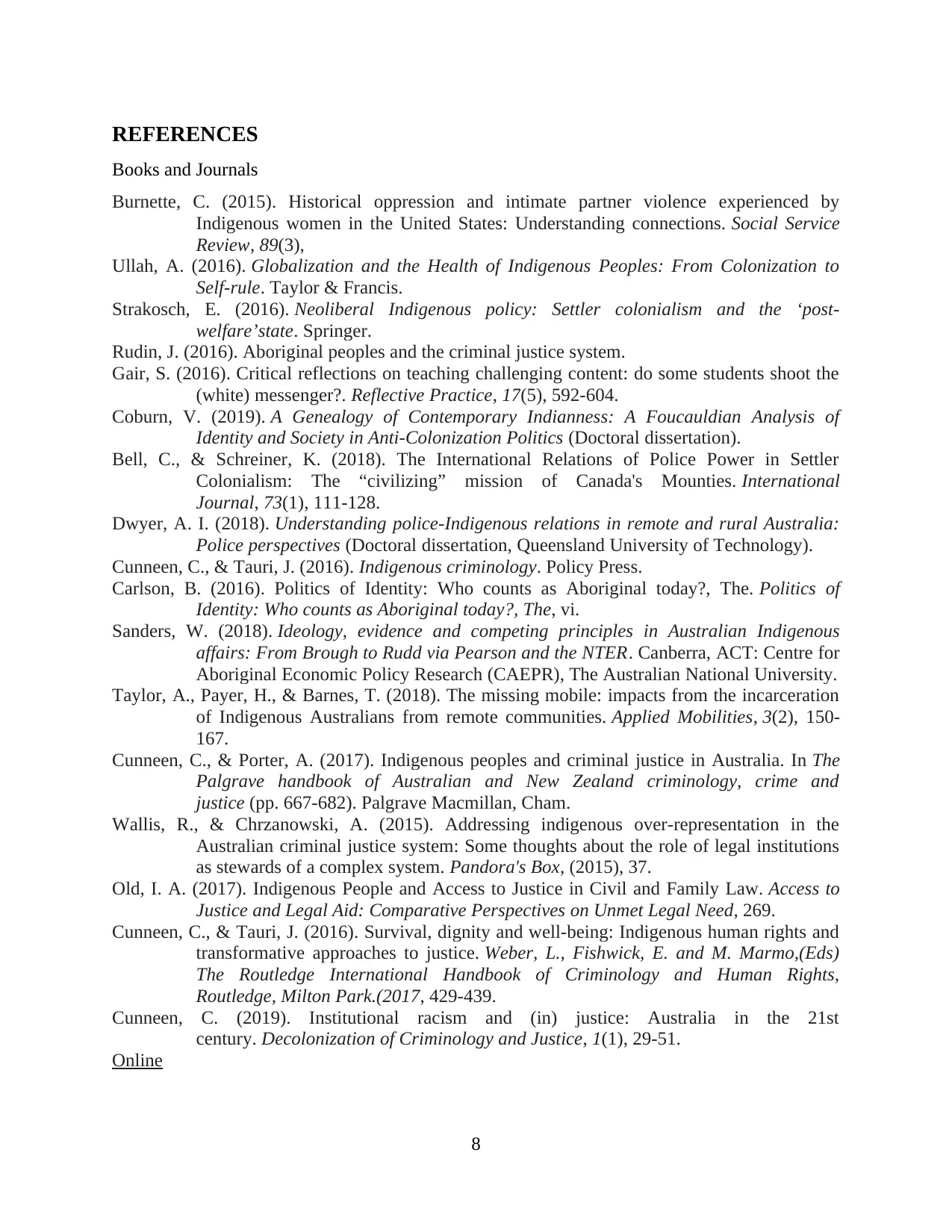
REFERENCES
Books and Journals
Burnette, C. (2015). Historical oppression and intimate partner violence experienced by
Indigenous women in the United States: Understanding connections. Social Service
Review, 89(3),
Ullah, A. (2016). Globalization and the Health of Indigenous Peoples: From Colonization to
Self-rule. Taylor & Francis.
Strakosch, E. (2016). Neoliberal Indigenous policy: Settler colonialism and the ‘post-
welfare’state. Springer.
Rudin, J. (2016). Aboriginal peoples and the criminal justice system.
Gair, S. (2016). Critical reflections on teaching challenging content: do some students shoot the
(white) messenger?. Reflective Practice, 17(5), 592-604.
Coburn, V. (2019). A Genealogy of Contemporary Indianness: A Foucauldian Analysis of
Identity and Society in Anti-Colonization Politics (Doctoral dissertation).
Bell, C., & Schreiner, K. (2018). The International Relations of Police Power in Settler
Colonialism: The “civilizing” mission of Canada's Mounties. International
Journal, 73(1), 111-128.
Dwyer, A. I. (2018). Understanding police-Indigenous relations in remote and rural Australia:
Police perspectives (Doctoral dissertation, Queensland University of Technology).
Cunneen, C., & Tauri, J. (2016). Indigenous criminology. Policy Press.
Carlson, B. (2016). Politics of Identity: Who counts as Aboriginal today?, The. Politics of
Identity: Who counts as Aboriginal today?, The, vi.
Sanders, W. (2018). Ideology, evidence and competing principles in Australian Indigenous
affairs: From Brough to Rudd via Pearson and the NTER. Canberra, ACT: Centre for
Aboriginal Economic Policy Research (CAEPR), The Australian National University.
Taylor, A., Payer, H., & Barnes, T. (2018). The missing mobile: impacts from the incarceration
of Indigenous Australians from remote communities. Applied Mobilities, 3(2), 150-
167.
Cunneen, C., & Porter, A. (2017). Indigenous peoples and criminal justice in Australia. In The
Palgrave handbook of Australian and New Zealand criminology, crime and
justice (pp. 667-682). Palgrave Macmillan, Cham.
Wallis, R., & Chrzanowski, A. (2015). Addressing indigenous over-representation in the
Australian criminal justice system: Some thoughts about the role of legal institutions
as stewards of a complex system. Pandora's Box, (2015), 37.
Old, I. A. (2017). Indigenous People and Access to Justice in Civil and Family Law. Access to
Justice and Legal Aid: Comparative Perspectives on Unmet Legal Need, 269.
Cunneen, C., & Tauri, J. (2016). Survival, dignity and well-being: Indigenous human rights and
transformative approaches to justice. Weber, L., Fishwick, E. and M. Marmo,(Eds)
The Routledge International Handbook of Criminology and Human Rights,
Routledge, Milton Park.(2017, 429-439.
Cunneen, C. (2019). Institutional racism and (in) justice: Australia in the 21st
century. Decolonization of Criminology and Justice, 1(1), 29-51.
Online
8
Books and Journals
Burnette, C. (2015). Historical oppression and intimate partner violence experienced by
Indigenous women in the United States: Understanding connections. Social Service
Review, 89(3),
Ullah, A. (2016). Globalization and the Health of Indigenous Peoples: From Colonization to
Self-rule. Taylor & Francis.
Strakosch, E. (2016). Neoliberal Indigenous policy: Settler colonialism and the ‘post-
welfare’state. Springer.
Rudin, J. (2016). Aboriginal peoples and the criminal justice system.
Gair, S. (2016). Critical reflections on teaching challenging content: do some students shoot the
(white) messenger?. Reflective Practice, 17(5), 592-604.
Coburn, V. (2019). A Genealogy of Contemporary Indianness: A Foucauldian Analysis of
Identity and Society in Anti-Colonization Politics (Doctoral dissertation).
Bell, C., & Schreiner, K. (2018). The International Relations of Police Power in Settler
Colonialism: The “civilizing” mission of Canada's Mounties. International
Journal, 73(1), 111-128.
Dwyer, A. I. (2018). Understanding police-Indigenous relations in remote and rural Australia:
Police perspectives (Doctoral dissertation, Queensland University of Technology).
Cunneen, C., & Tauri, J. (2016). Indigenous criminology. Policy Press.
Carlson, B. (2016). Politics of Identity: Who counts as Aboriginal today?, The. Politics of
Identity: Who counts as Aboriginal today?, The, vi.
Sanders, W. (2018). Ideology, evidence and competing principles in Australian Indigenous
affairs: From Brough to Rudd via Pearson and the NTER. Canberra, ACT: Centre for
Aboriginal Economic Policy Research (CAEPR), The Australian National University.
Taylor, A., Payer, H., & Barnes, T. (2018). The missing mobile: impacts from the incarceration
of Indigenous Australians from remote communities. Applied Mobilities, 3(2), 150-
167.
Cunneen, C., & Porter, A. (2017). Indigenous peoples and criminal justice in Australia. In The
Palgrave handbook of Australian and New Zealand criminology, crime and
justice (pp. 667-682). Palgrave Macmillan, Cham.
Wallis, R., & Chrzanowski, A. (2015). Addressing indigenous over-representation in the
Australian criminal justice system: Some thoughts about the role of legal institutions
as stewards of a complex system. Pandora's Box, (2015), 37.
Old, I. A. (2017). Indigenous People and Access to Justice in Civil and Family Law. Access to
Justice and Legal Aid: Comparative Perspectives on Unmet Legal Need, 269.
Cunneen, C., & Tauri, J. (2016). Survival, dignity and well-being: Indigenous human rights and
transformative approaches to justice. Weber, L., Fishwick, E. and M. Marmo,(Eds)
The Routledge International Handbook of Criminology and Human Rights,
Routledge, Milton Park.(2017, 429-439.
Cunneen, C. (2019). Institutional racism and (in) justice: Australia in the 21st
century. Decolonization of Criminology and Justice, 1(1), 29-51.
Online
8
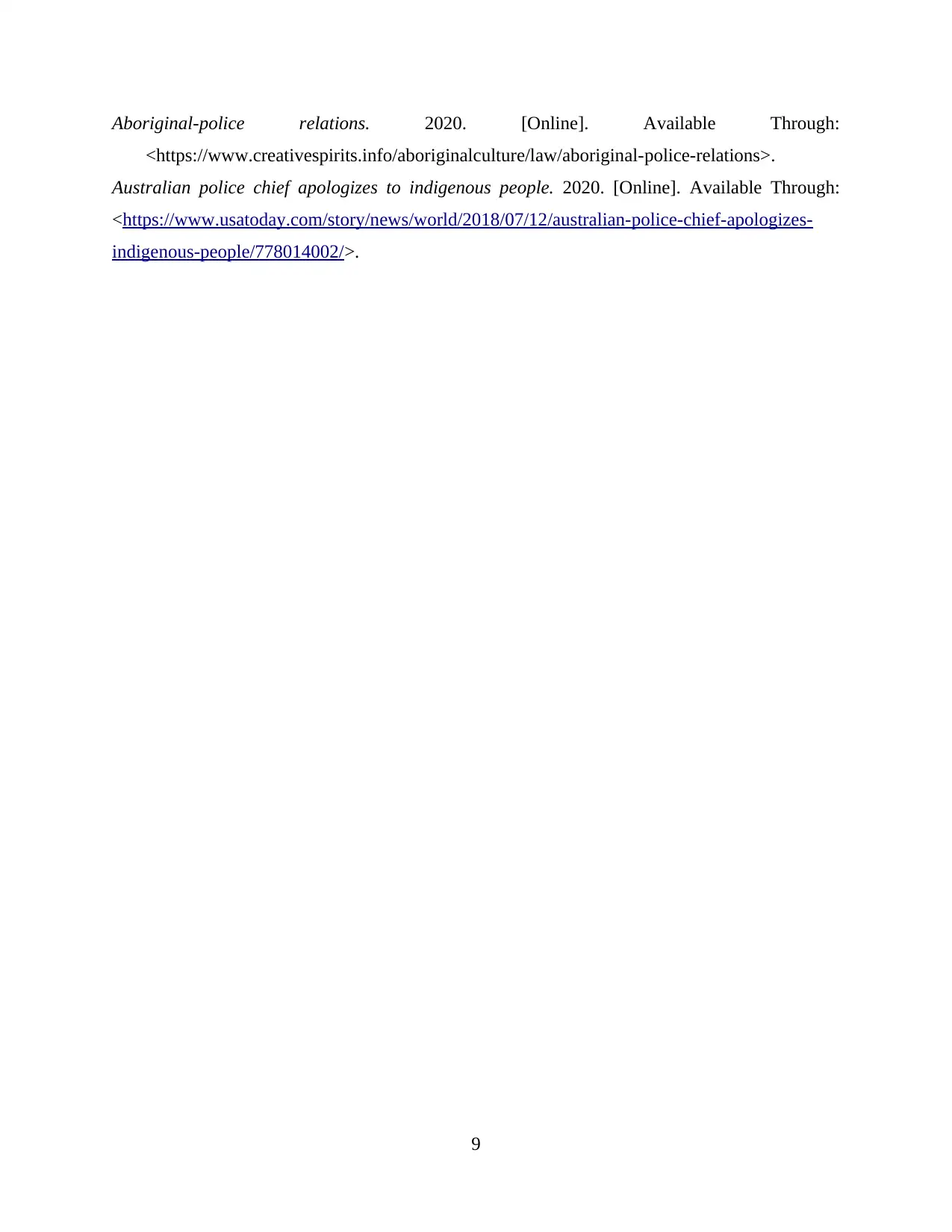
Aboriginal-police relations. 2020. [Online]. Available Through:
<https://www.creativespirits.info/aboriginalculture/law/aboriginal-police-relations>.
Australian police chief apologizes to indigenous people. 2020. [Online]. Available Through:
<https://www.usatoday.com/story/news/world/2018/07/12/australian-police-chief-apologizes-
indigenous-people/778014002/>.
9
<https://www.creativespirits.info/aboriginalculture/law/aboriginal-police-relations>.
Australian police chief apologizes to indigenous people. 2020. [Online]. Available Through:
<https://www.usatoday.com/story/news/world/2018/07/12/australian-police-chief-apologizes-
indigenous-people/778014002/>.
9
⊘ This is a preview!⊘
Do you want full access?
Subscribe today to unlock all pages.

Trusted by 1+ million students worldwide
1 out of 12
Related Documents
Your All-in-One AI-Powered Toolkit for Academic Success.
+13062052269
info@desklib.com
Available 24*7 on WhatsApp / Email
![[object Object]](/_next/static/media/star-bottom.7253800d.svg)
Unlock your academic potential
Copyright © 2020–2025 A2Z Services. All Rights Reserved. Developed and managed by ZUCOL.




